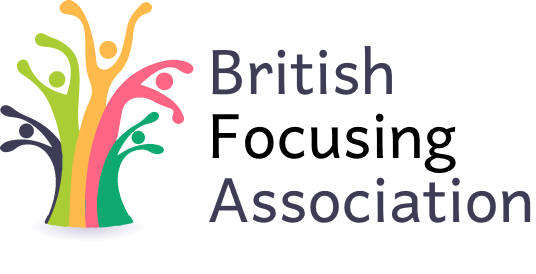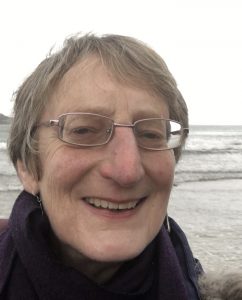Therapy
Susan Jordan and Sally Nealon
Published in The Fulcrum, the craniosacral journal.
Many craniosacral therapists already use Focusing as a tool to deepen awareness and ground experiences in the body. Those who are not familiar with it may be interested to know more about what it can offer to both therapist and client in cranio-sacral work.
For those who have not met it before, Focusing was discovered or identified in the 1950s by Eugene Gendlin, a philosopher and psychotherapist who worked with Carl Rogers on his research into what made counselling or psychotherapy effective. Gendlin found that those people who were able to make contact with the bodily sense of their process, which he named the “felt sense”, were more likely to experience changes during therapy than those whose understanding of themselves was less connected with their inner sensing. He developed Focusing as a way of teaching this skill, which we all use naturally to some extent, to those who do not access it so readily(1).
In craniosacral work, as with other forms of bodywork, if the client can sense into what is happening, including their own resistance to it, they are already on the way to allowing the process to move through more freely. This then makes a connection to what Franklyn Sills (2) describes as the “inner realm which allows access to how we hold meaning in an embodied way”. Through bodily sensing, Focusing provides a way of experiencing this meaning. If the client does not seem able to sense into the body, this may be because the shock and trauma, often too early to be consciously remembered, have caused them to freeze or dissociate. It is easy to assume that if someone is not sensing anything, this means they are not accessing the felt sense. In fact the apparent nothing is ‘something’, and by acknowledging it the client can begin to make more space around it. The practitioner can help the client to do this through the non-judgemental acceptance of whatever arises, and perhaps by reflecting back in a Focusing way (see below).
It is sometimes difficult for people to distinguish between feeling an emotion, which will probably be expressed as “I’m angry”, “I’m scared”, and sensing into it, which Focusing might express as “I’m noticing that something in me is feeling scared”. Further sensing might reveal that the “something” is not only scared but also perhaps hurt or outraged, or whatever else it may happen to be. Sensing into it in this way can enable someone to disidentify without dissociating, to be with the experience rather overwhelmed by it. The practitioner’s presence and ability hold the larger space can help the client to do this. In Focusing there is an implicit trust of the process, and also an acknowledgement that at times something may simply be too much for the person to be with.
Peter Levine (3) talks of the importance of bodily sensation in processing trauma and uses felt sensing as a way of helping people to reconnect with their experience. Michael Kern (4) also refers to this in the context of craniosacral work. As the client begins to re-associate with the dissociated sensation, the body can start to release the trauma by shaking or other forms of discharge. A Focusing attitude can help the client to acknowledge the process as it is happening and sense what more needs to come. This can generate an attitude of acceptance which makes it possible to be with distress and disturbance. Focusing-type interventions such as “perhaps you could just see what that feels like” may help to facilitate the process, as can the judicious use of reflection (“so that feels really heavy” etc), which can help the client to connect more deeply with the experience. If someone is asked “How are you feeling now?” their immediate response may be to say “I feel fine”. The practitioner can then ask if the client can sense what the ‘fine’ feels like, and this may carry the process forward. Alternatively, rather than asking “How do you feel?”, it can sometimes be more useful to ask how it feels (i.e. the particular place, sensation or emotion). This can help the client to become interested in the process rather than identified with the emotion – or lack of emotion. In this way the client has access not only to emotion but to feeling, which is the subtle interface between emotion and bodily sensing, and which may include thought and imagery.
Focusing can also be directly helpful to practitioners. By checking inside from time to time, they can notice when they have slipped out of ‘practitioner neutral’ and been drawn into the client’s process. This noticing can give the space to re-set fulcrums and come back into what Focusing describes as Presence, i.e. the sense of the larger holding field. If the practitioner is aware of feeling uncomfortable, they can take a moment to sense what is happening in the relational field and whether the discomfort is theirs or the client’s, or both. Learning to do this and to hold the neutral state is particularly important for new practitioners.
If a client is experiencing strong emotion or bodily manifestations such as violent movement, a new practitioner’s first reaction may well be “What on earth do I do?” Sensing into oneself at such moments, and helping the client to sense into themselves, can open up the space in which the process can complete. When working with physical manifestations which seem overwhelming to the client, such as unexplained pain or nerve impulses in particular areas, the practitioner can easily begin to feel overwhelmed. Taking a moment or two to acknowledge that “something in me” is feeling overwhelmed can help to hold the whole space and enable the practitioner to step back from feeling responsible. If the client experiences extreme tension, the practitioner can help the client to relax simply by acknowledging that this is there, rather than taking on the tension and struggling with it.
In all of this, Focusing can support being with what arises rather than becoming it. When this is difficult for the client, the practitioner’s presence and ability to be with themselves can create safety. Cranio-sacral therapy works non-verbally with the relational field, and this can have a profound effect. In addition, the verbal ways of reflecting and supporting process which Focusing teaches can enable clients to hold themselves with more space and compassion.
If you are interested in finding out more about Focusing, you can visit the British Focusing Teachers’ Association website, www.focusing.org.uk. A number of Focusing teachers offer courses in different parts of the country and individual sessions are also an option. Other websites with articles and further links are the Focusing Institute, www.focusing.org, and Focusing Resources, www.focusingresources.com.
Susan Jordan is a British Focusing Teachers’ Association recognised Focusing teacher and a Focusing Institute certified trainer. She is also a UKCP registered Core Process psychotherapist and trained at the Karuna Institute with Maura and Franklyn Sills. She offers Focusing courses and individual sessions in London. Her website address is www.susanjordan.net.
Sally Nealon, RCST, is a senior tutor at CTET and a visiting tutor at the University of Westminster’s School of Integrative Health. She trained at CTET with Michael Kern and Franklyn Sills. She has a private craniosacral practice in North West London and can be contacted at .
- 1 Gendlin, Eugene Focusing (2nd edition), Bantam New Age Books (1982)
- 2 Sills, Franklyn Craniosacral Biodynamics, North Atlantic Books (2001, 2004)
- 3 Levine, Peter Waking the Tiger, North Atlantic Books (1997)
- 4 Kern, Michael Wisdom in the Body, North Atlantic Books (2006)

